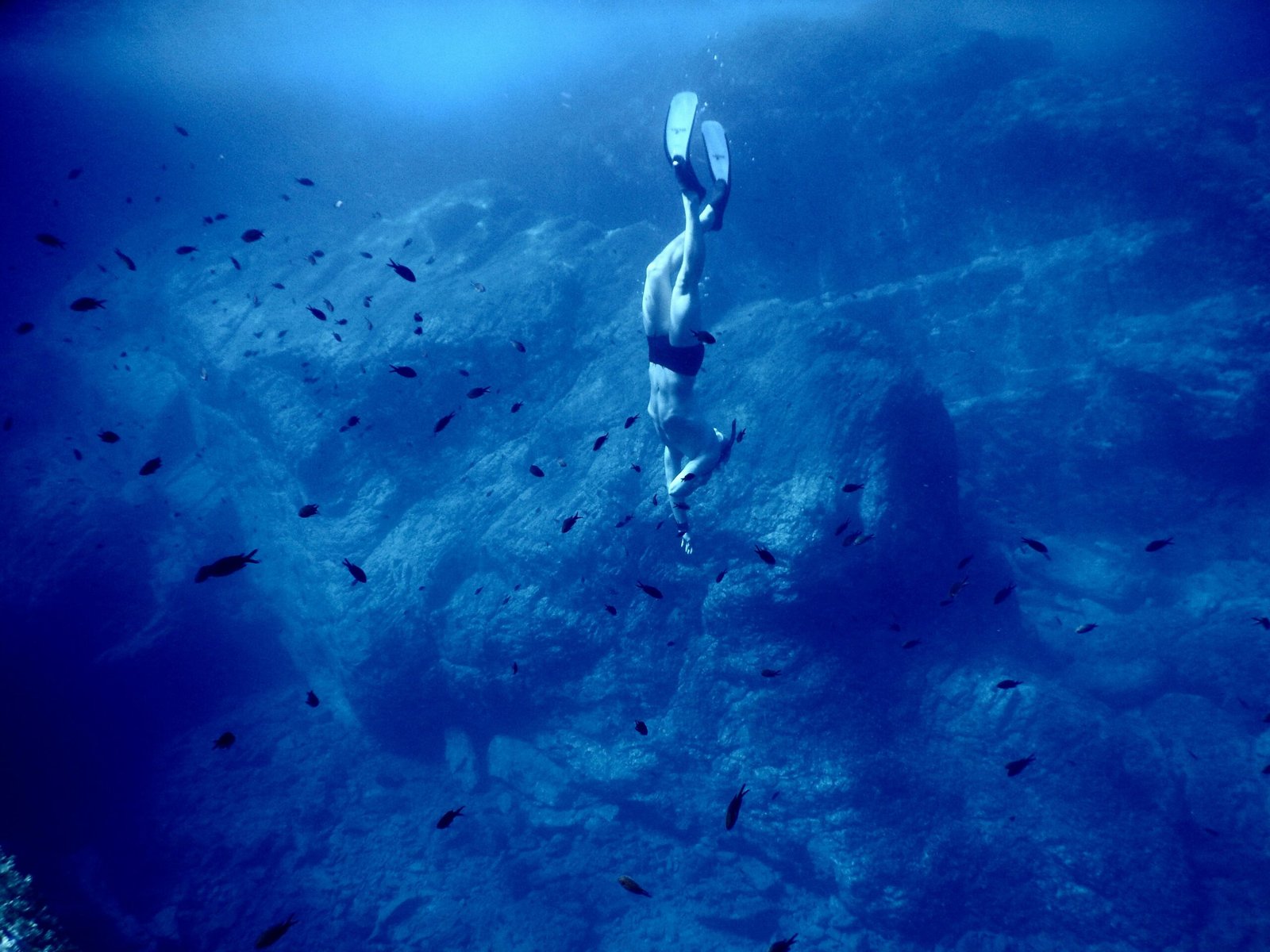Introduction to the Deep Sea
The deep sea is one of the most enigmatic and least understood regions of our planet, extending from a depth of approximately 200 meters to the ocean floor, which can reach depths of over 10,000 meters in some areas. This vast underwater domain is distinguished from other oceanic zones, such as the epipelagic zone, which is the well-lit surface layer where most marine life thrives. The deep sea is characterized by its extreme conditions, including high pressure, low temperatures, and complete darkness, making it a challenging environment for life to exist.
In the depths of the ocean, the complexities of ecosystems flourish in silence, creating habitats that are primarily self-sustaining and highly specialized. Life forms in the deep sea have evolved unique adaptations to survive these harsh settings, often resulting in fascinating physiological traits. For instance, many deep-sea creatures, such as bioluminescent organisms, rely on light produced chemically for communication or predation, a phenomenon rarely seen in shallower zones. This remarkable ability highlights the biological diversity found in deep-sea habitats.
Despite covering a significant portion of the Earth’s surface, the deep sea has historically been overlooked in marine research. The challenging conditions make exploration difficult, leading to limited knowledge about the diverse organisms and ecosystems present in this mysterious realm. Studying the deep sea is vital not only for understanding the myriad forms of life that reside there but also for assessing the impacts of climate change, pollution, and human activity on these fragile environments. As technology advances, we gain deeper insights into the deep sea, allowing us to uncover its secrets and appreciate its role in the overall health of our planet.
The Fascinating Ecosystem of the Deep Sea
The deep sea represents one of the most enigmatic and least explored environments on Earth, hosting a complex and diverse ecosystem. This expansive underwater realm, typically defined as depths below 200 meters, is characterized by extreme conditions such as high pressure, low temperatures, and minimal light. Despite these seemingly inhospitable surroundings, a remarkable variety of life forms thrive here, each uniquely adapted to survive where conventional organisms cannot.
One of the defining features of the deep sea ecosystem is its extraordinary biodiversity. Researchers estimate that approximately 230,000 species have been identified in the deep sea, with many more likely yet to be discovered. These organisms display various adaptations, such as large eyes to gather as much light as possible in the perpetual darkness and specialized body structures to withstand intense pressure. Among the notable inhabitants are giant squid, deep-sea jellyfish, and bioluminescent organisms that illuminate the abyss with their natural glow.
Bioluminescence, in particular, is a captivating phenomenon within this ecosystem. Many deep-sea creatures, including certain species of fish and squid, possess the ability to produce light through chemical reactions in their bodies. This adaptation serves multiple purposes, such as attracting prey, communicating with potential mates, or evading predators. Hydrothermal vents, another intriguing aspect of the deep sea, emerge from the ocean floor, releasing mineral-rich, superheated water. These vents create unique microhabitats that support life forms, including giant tube worms and specialized bacteria, which utilize chemosynthesis rather than photosynthesis for energy. This process is a crucial element in sustaining the deep sea food web.
Overall, the fascinating ecosystem of the deep sea illustrates the remarkable resilience and adaptability of life in extreme conditions. As research continues to uncover the mysteries of this hidden world, it becomes increasingly clear that the deep sea is vital to the planet’s overall health and biodiversity.
Unusual Adaptations of Deep Sea Creatures
The deep sea represents one of the most hostile environments on Earth, characterized by extreme pressure, cold temperatures, and complete darkness. To survive in these challenging conditions, deep-sea creatures have developed a range of remarkable adaptations that allow them to thrive where few other organisms can. Among these adaptations, tolerance to immense pressure is a critical feature. Many deep-sea species possess flexible bodies and specialized biochemical processes that prevent their cells from being crushed. For instance, the Pacific snailfish is known to endure depths of over 8,000 meters, showcasing its extraordinary ability to adapt to the crushing depths of the ocean.
Another intriguing adaptation seen in deep-sea organisms is the evolution of unique feeding strategies. In an environment where food can be scarce, many deep-sea creatures have developed specialized hunting techniques to capture prey. The anglerfish, for example, employs a bioluminescent lure that attracts smaller fish in the darkness of the deep sea. This adaptation not only aids in survival but also illustrates the innovative methods these creatures use to obtain nourishment despite their surroundings.
Camouflage is yet another fascinating adaptation employed by deep-sea inhabitants. The darkness of the deep ocean provides an opportunity for many creatures to utilize coloration and structural features to avoid detection by predators or prey. The transparent bodies of certain species, like the glass octopus, or the use of counter-illumination by organisms such as the cookiecutter shark, ensure successful concealment in an environment devoid of light.
Through these adaptations, deep-sea creatures exemplify the incredible resilience and versatility of life, revealing how evolution enables survival under some of the planet’s most extreme conditions. These unusual characteristics underscore the importance of studying these organisms to better understand their ecological roles and the broader implications for marine biodiversity.
Creatures of the Abyss: Notable Deep Sea Species
The deep sea is a realm of mystery and wonder, home to a diverse array of fascinating creatures, each uniquely adapted to survive in the extreme conditions of the ocean’s depths. Among these intriguing inhabitants are the anglerfish, giant squid, and vampire squid, each embodying the bizarre and captivating nature of life in the abyss.
The anglerfish, distinguished by its bioluminescent lure, represents one of the most fascinating adaptations for survival. This deep-sea predator uses its glowing appendage to attract unsuspecting prey in the dark waters. With large mouths and expandable stomachs, anglerfish can consume prey that is much larger than themselves, showcasing an effective hunting strategy in an environment where food can be scarce.
Equally notable is the giant squid, an elusive creature that has long captured human imagination. Known for its remarkable size, with some specimens growing up to 43 feet in length, this cephalopod showcases powerful tentacles lined with suction cups. While its habitat lies largely uncharted, the giant squid’s ability to navigate the deep through jet propulsion allows it to maintain stealth and agility, essential for evading predators such as the sperm whale.
The vampire squid, despite its name, is neither a vampire nor technically a squid. This deep-sea species possesses a unique appearance, characterized by a cloak-like web of skin connecting its arms. Contrarily, it feeds on marine detritus, utilizing its specially adapted feeding method to thrive in low-oxygen environments. Its bioluminescent capabilities and ability to withstand high-pressure underwater make it a compelling example of evolutionary ingenuity.
These remarkable species not only highlight the extraordinary adaptability of life in the deep sea but also remind us of the vast, unexplored territories that still remain in our oceans. As scientific exploration continues, new discoveries may reveal even more incredible creatures that inhabit the abyss.
The Role of Technology in Exploring the Deep Sea
The exploration of the deep sea, a realm shrouded in darkness and mystery, has advanced significantly due to technological innovations. Traditionally, studying deep-sea creatures was fraught with challenges, including extreme pressure, freezing temperatures, and complete darkness. However, technological advancements have enabled scientists to uncover the hidden wonders of these underwater ecosystems, expanding our understanding of deep-sea life.
One pivotal advancement is the development of submersibles. These specially designed vessels allow researchers to descend to great depths, providing an opportunity to observe marine life in their natural habitats. Equipped with advanced cameras and sampling tools, submersibles can capture high-definition images and videos, and even collect specimens from the ocean floor. By minimizing human presence in these depths, submersibles facilitate a more accurate assessment of the behavior and ecology of deep-sea creatures.
Another critical innovation in deep-sea exploration is the use of remotely operated vehicles (ROVs). ROVs are unmanned, robotic submarines that can be deployed to depths beyond human reach. Operated from a ship above, these vehicles are equipped with sophisticated sensors, cameras, and manipulators, enabling scientists to explore and document life forms and geological features on the seafloor. The versatility of ROVs allows for extensive data collection, which has proven essential for studies on the biodiversity and distribution of deep-sea organisms.
In addition to submersibles and ROVs, advanced sonar systems have revolutionized underwater mapping and exploration. Sonar technology enables researchers to create detailed maps of the ocean floor, revealing previously unknown habitats and geological formations. By integrating sonar data with other technological tools, scientists can better understand the complex interactions between deep-sea creatures and their environments.
Ultimately, the convergence of these technological advancements underscores our growing ability to investigate and appreciate the intricate world of deep-sea life.
The Impact of Human Activity on Deep Sea Ecosystems
Deep sea ecosystems face numerous threats primarily driven by human activities. These profound marine environments, often characterized by extreme conditions, are becoming increasingly vulnerable to a myriad of pressures due to advancements in technology and industrialization. One of the most pressing concerns is deep-sea mining, which involves the extraction of valuable minerals and resources from the ocean floor. This practice disrupts the delicate balance of these ecosystems, leading to habitat destruction and the potential extinction of specialized species. As valuable resources are pursued, the irreversible impact of such activities on biodiversity cannot be overstated.
Another significant threat comes from pollution, which infiltrates deep sea habitats through various channels. Plastic waste, heavy metals, and chemicals these oceans all contribute to the deterioration of marine life and their habitats. Pollutants can lead to bioaccumulation and biomagnification in deep-sea organisms, disturbing the food web and posing risks to higher predators, including humans. The extent of pollution at such depths is often underestimated, yet its consequences are profound, highlighting the need for stricter waste management practices and policies to mitigate these effects.
Climate change further exacerbates the challenges faced by deep-sea ecosystems, resulting in changing temperatures, ocean acidification, and altered ocean currents. These changes have the potential to impact the distribution and behavior of deep-sea species, which rely on specific environmental conditions for survival. The interconnectedness of these ecosystems means that alterations in one region can have cascading effects, impacting local fishing industries dependent on healthy marine stocks. Thus, understanding and addressing human impacts on the deep ocean is critical.
In conclusion, safeguarding deep-sea ecosystems is of utmost importance. Ensuring sustainable practices and conservation efforts can help preserve these fragile environments for future generations. Addressing the challenges posed by human activity is vital to maintaining the health and integrity of our planet’s oceans.
Deep Sea Mythology and Cultural Significance
The deep sea has long fascinated humanity, inspiring innumerable myths, legends, and artistic expressions throughout history. Many ancient civilizations regarded the ocean’s depths as a mysterious realm inhabited by powerful creatures, which often played significant roles in their cultural narratives. For instance, in Greek mythology, the sea was governed by Poseidon, the god of the ocean, who was often depicted with mythical sea creatures. Such stories not only captured the imagination but also served as metaphors for the unpredictable nature of the sea.
In Norse mythology, the deep sea was home to a variety of enigmatic beings, including mermaids and krakens. These creatures encapsulated both beauty and terror, representing the duality of the ocean as a life-sustaining entity and a treacherous force. Similarly, in Japanese folklore, the deep-sea creature Umibōzu personified the fierceness of storms and the unpredictable temperament of the ocean, reflecting deep-seated cultural reverence for the sea’s power.
Furthermore, literature and art have also drawn heavily from the symbolism found within deep-sea creatures. From Herman Melville’s “Moby Dick,” featuring the notorious white whale, to modern representations in film such as “Finding Nemo,” the deep sea has provided an extensive palette for exploring human emotions, fears, and dreams. Not only do these narratives highlight the ecological significance of deep-sea habitats, but they also challenge us to confront our relationship with the natural world.
In contemporary times, deep-sea creatures have become icons in popular culture, often used to illustrate themes of mystery and discovery. Documentaries and films focusing on marine exploration serve to educate and inspire, revealing the intricate beauty and fragility of deep-sea ecosystems. Through these various forms of expression, the cultural significance of deep-sea mythology continues to evolve, fostering an ongoing connection to the mysteries that lie beneath the ocean’s surface.
Recent Discoveries in Deep Sea Exploration
Recent advancements in deep-sea exploration have unveiled a plethora of fascinating discoveries that significantly enhance our understanding of marine biodiversity and the intricate roles of deep-sea organisms within their ecosystems. As technology develops, scientists have the ability to explore previously uncharted territories of the ocean, revealing a multitude of species that were earlier unknown to science.
One of the most notable findings is the discovery of new bioluminescent species, which emit light through biochemical reactions. Researchers have identified various organisms, from jellyfish to deep-sea fish, that use bioluminescence for communication, predation, or camouflage. These adaptations provide unique insights into the survival strategies of deep-sea creatures and their ecological niches in the dark depths of the ocean.
Additionally, recent expeditions have highlighted the importance of deep-sea hydrothermal vent ecosystems. These unique environments, where heated, mineral-rich water emerges from the seafloor, serve as habitats for a variety of specialized organisms. Studies have shown that these communities have intricate food webs supported by chemosynthesis, a process where microorganisms convert chemical energy from the vent fluids into organic compounds, which then become the foundation for a range of complex life forms.
Moreover, genetic analyses of newly discovered species have revealed unexpected evolutionary relationships among deep-sea organisms, suggesting that biodiversity in these environments is more interconnected than previously thought. The findings not only underscore the need for conservation efforts but also pose significant questions about the resilience of these ecosystems amidst rising ocean temperatures and human-induced changes.
In conclusion, recent discoveries in deep-sea exploration are reshaping our understanding of the ocean’s biodiversity and the ecological functions of its inhabitants. As researchers continue to delve deeper into these mysterious waters, they uncover the remarkable adaptability and resilience of deep-sea creatures, emphasizing the importance of preserving these unique ecosystems for future generations.
Conclusion: The Future of Deep Sea Exploration
The exploration of deep sea environments is a critical endeavor that holds immense significance for our understanding of marine ecosystems and their impact on the global climate. As technology advances, researchers are equipped with sophisticated tools that facilitate deeper dives and more extensive surveys of the ocean floor. This ongoing quest for knowledge allows us to uncover the myriad of life forms that thrive in the challenging conditions of the deep ocean, many of which remain undocumented and enigmatic.
Investigating deep-sea creatures not only enriches our scientific comprehension but also raises awareness about the crucial roles these organisms play within their ecosystems. From bioluminescent organisms that illuminate the inky depths to massive whale-fall communities that flourish around the carcasses of deceased giants, the interactions among different species can provide valuable insights into life cycles and biodiversity. As we continue to delve into these incredible habitats, we gain knowledge that is pivotal for conservation efforts, particularly in the face of increasing threats from climate change and human activities.
Furthermore, enhanced exploration efforts are paramount for identifying new species that could contribute to breakthroughs in medicine and biotechnology. For example, certain deep-sea organisms possess unique biochemical properties that have the potential to inspire innovations in pharmaceuticals and materials science. By shedding light on these remarkable adaptations, we stand to benefit greatly from the resources that the ocean’s depths offer.
In summary, the future of deep sea exploration is filled with promise, as it emphasizes the importance of understanding our planet’s least explored regions. It encourages continued scientific inquiry and fosters a sense of responsibility to protect the ocean’s hidden treasures. As stewards of the Earth, we must support initiatives aimed at uncovering the mysteries of deep sea creatures and advocate for sustainable practices that will preserve these vital ecosystems for future generations to explore and appreciate.



